This was published 5 years ago
Vasa Museum, Stockholm: The greatest ship that never sailed
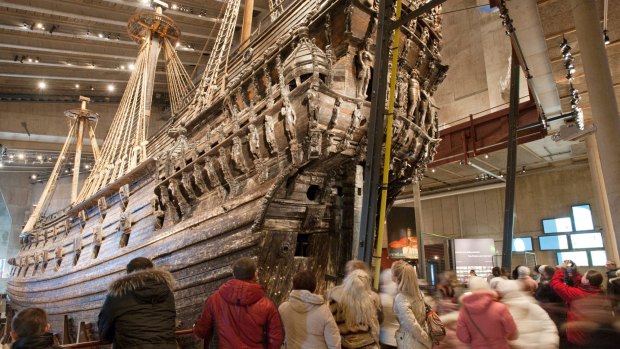
Visitors at the stern of the Vasa.
Few museums get personal, but in Stockholm's Vasa Museum you're introduced to Ivar, 173 centimetres tall, aged around 50, with worn teeth and a healed injury on his skull. He was more than just an ordinary sailor – perhaps he was guarding the gunner's stores – since he had silver buttons on his jacket. He carried a military-issue musket and a lantern. In 1628, he was down on Vasa's orlop deck, where there would have been no natural light. Without warning, his world started to tilt. The brand-new Swedish navy flagship sank into Stockholm harbour and Ivar was drowned.
Sometimes we forget that history is filled with terrible tales, especially in Europe, where the past is often glamorised for tourists. Vasa Museum is a timely reminder. Certainly, the ship is entrancing. Vasa, almost entirely preserved in the Baltic's chilly oxygen-poor water and salvaged in 1961, is the world best-preserved historic ship. Nearly all its contents have been salvaged too: stunning gargoyles and carved candlesticks, sailors' trousers, pewter beer tankards and 700 sculptures.

Getting personal with one of the sailors.
But here you're constantly reminded of its horror sinking in front of assembled onlookers, and the individuals who lost their lives in the disaster.
About 50 sailors were on board, some with their families. There was no manifest, so only the names of a few senior officers are known. The rest have been assigned names by museum staff in a pleasing touch of humanity. Helge was around 35 years old, not so tall. He was pinned under a gun carriage as the ship sank, and had a knife and 35 coins in his pockets. Johann was older and shorter, and died in the anchor room. He was dressed in high-quality wool fabric and good shoes, but he'd had a hard life. His hip was worn out, his lower teeth pulled, he had an old broken leg that hadn't healed cleanly. The 17th century wasn't such a great place, even for the well-off.
"He was a scarred old man," says Martina Siegrist Larsson fondly. She's the museum's information officer and showing me around. Although she's worked here for a long time, there's no doubting her enthusiasm for this magnificent relic.The royal flagship Vasa was supposed to be the most powerful, state-of-the-art fighting ship in the Baltic at a time when Sweden was a major European power. Yet it only sailed 1300 metres before it sank. It's the world's most magnificent yet useless warship, the pride of Sweden gone wrong. As Martina explains, Vasa was top-heavy with 64 cannons – most ships had 48 – placed quite high up the ship, which was already weighed down with rigging and showy sculptures. It probably had its gunports open to fire a salute and show off to best effect during its grand launch. "And there wasn't enough ballast in the hold," adds Martina. "The lower part of the ship should probably have been wider to hold more ballast. It was a ship just waiting to sink."
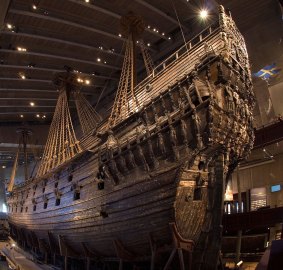
The Vasa seen from the stern.
History's tragedy is our gain. Vasa encapsulates the story of 17th-century naval warfare, ship-building and on-board life. The ship is oak, the carvings made from linden wood. (The masts, which were pine, haven't survived.) The range of items pulled up with the ship is astonishing: entire seamen's chests, racks of pewter-ware stamped with their owner's marks, carpentry tools, weapons. Displays show linen shirts, stockings, woollen jackets and doublets and breeches. Wool doesn't rot in water, so there's plenty of it.
There are shoes and boots in great condition, and awls and pegs that were used for attaching and mending soles. There are ordinary soldiers' wooden bowls and spoons, and officers' metal bowls, glassware and ceramics. There are rifles and fishing sinkers and sliding-lid boxes, two bronze cannons, a barrel full of butter and a backgammon set.Below the prow of the ship, you can look down into workshops where conservationists are still working on artefacts and skeletons. "The research and knowledge continues, as we are always finding out new things with new technologies," says
Martina proudly. "There's no end to it, it's fantastic. It's important we keep on learning."
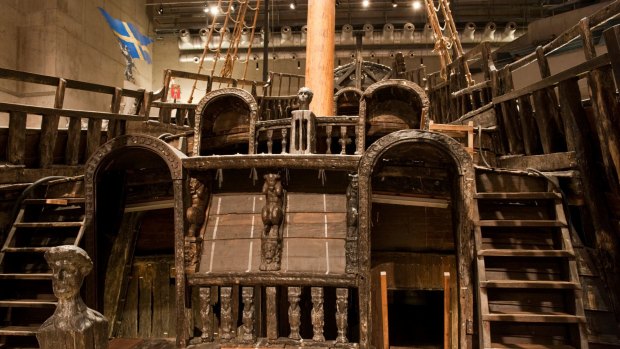
Upper deck (towards the stern) of the Vasa.
The museum is brilliantly presented. It has to be, given that it really has only a single exhibit, even if it is an entire ship. Vasa sits in humidity-controlled, dramatic gloom, like a ghost ship from Pirates of the Caribbean. Because you can't walk through the fragile ship itself – and it is so intact you can't see inside either – parts have been recreated in separate areas of the museum, including the captain's cabin and the upper gun deck. A cross-section of the ship provides a useful snapshot of its interior layout. There's also an interesting exhibit on how the ship was raised in a considerable feat of engineering and archaeology.
You enter the museum at roughly the ship's waterline, but one of the best places from which to admire the whole magnificent thing is from the seventh floor, right at the back of the building, where there are hardly any visitors and you can see over the entire vessel. The carvings at the rear of the ship are remarkably ornate, depicting sea creatures, mythological Greeks, angels, and Roman and Swedish kings. They would have been brightly painted, as a model garish in reds and greens shows.
Several other floors, however, bring you up close to different parts of Vasa, so you can admire it from almost every angle, get an up-close look at gunports and carvings, and might even see museum staff working on preservation. Currently the ship, which is sinking under its own weight, is having its 1960s iron bolts replaced with stainless-steel alternatives.
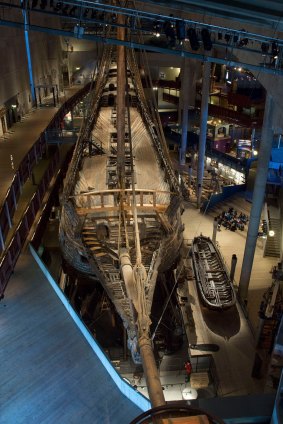
The Vasa seen from the upper floors.
"We're always the pioneers, since there's no other ship like this in the world," says Martina. "Whenever any problem shows up, we just have to work it out."
And, to its credit, one of the things the museum works out is whether they can identify the people on board who lost their lives. That's likely an impossible task, but DNA analysis can now show where they came from, and whether they're related. Ivar, it seems, had a brother the museum has called Martin, who perished as well. As did Filip, an oarsman in the steering cabin. He was maybe only 30, 163 centimetres tall, skinny and probably a vegetarian. He could have scrambled up a short ladder onto the open deck. Maybe he stayed to try and steer the ship ashore. You have to wonder here, in this museum full of wonders.
FIVE MORE STOCKHOLM MUSEUMS
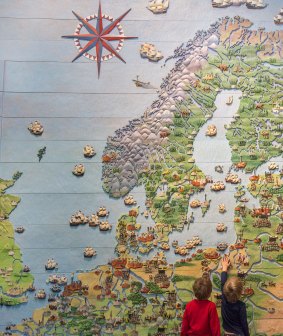
Young visitors at a map of the Baltic at the Vasa Museum.
NATIONAL MARITIME MUSEUM
If you're interested in more maritime history, this free museum near the Vasa takes a look at Swedish naval and merchant shipping from the 17th century onwards. There are entrancing model ships and parts of a salvaged World War II submarine. See maritima.se
SWEDISH HISTORY MUSEUM
Exhibits here put the city into its historical context from the Stone Age to current times. It has especially good galleries devoted to prehistoric gold objects and jewellery, and one of the world's most extensive Viking-related collections. See historiska.se
ABBA: THE MUSEUM
Take a break from high culture (and say thank you for the music), at this unabashedly kitschy, nostalgic museum devoted to Sweden's greatest export. Sing along with ABBA holograms, boogie on a dance floor and inspect outrageous costumes and memorabilia. See abbathemuseum.com
SKANSEN
Care for fresh air? You could dawdle around this open-air museum for the better part of a day, especially with kids in tow. It brings together 150 relocated historic buildings, including farmhouses, churches and manors, brought to life by costumed and crafts-making staff. See skansen.se
NOBEL MUSEUM
Find out more about Swedish industrialist and dynamite inventor Alfred Nobel and his prestigious prizes at this museum. There's an interesting examination of what produces creative minds, and a focus on some of the most significant prize-winners. See nobelcenter.se
TRIP NOTES
MORE
traveller.com.au/sweden visitstockholm.com
FLY
Emirates flies from Sydney and Melbourne to Dubai (14.5hr) with onward connections to Stockholm (6.5 hr). Phone 1300 303 777, see emirates.com/au
TOUR
Entry to the Vasa Museum is SEK130 ($20), free for under-18s. Guided tours, which run regularly, are included. See vasamuseet.se
STAY
Centrally located Clarion Hotel Sign provides design-conscious digs with friendly staff, a buzzing atmosphere and great buffet breakfast. See nordicchoicehotels.se
Brian Johnston travelled courtesy Celebrity Cruises and Visit Stockholm.
Sign up for the Traveller Deals newsletter
Get exclusive travel deals delivered straight to your inbox. Sign up now.